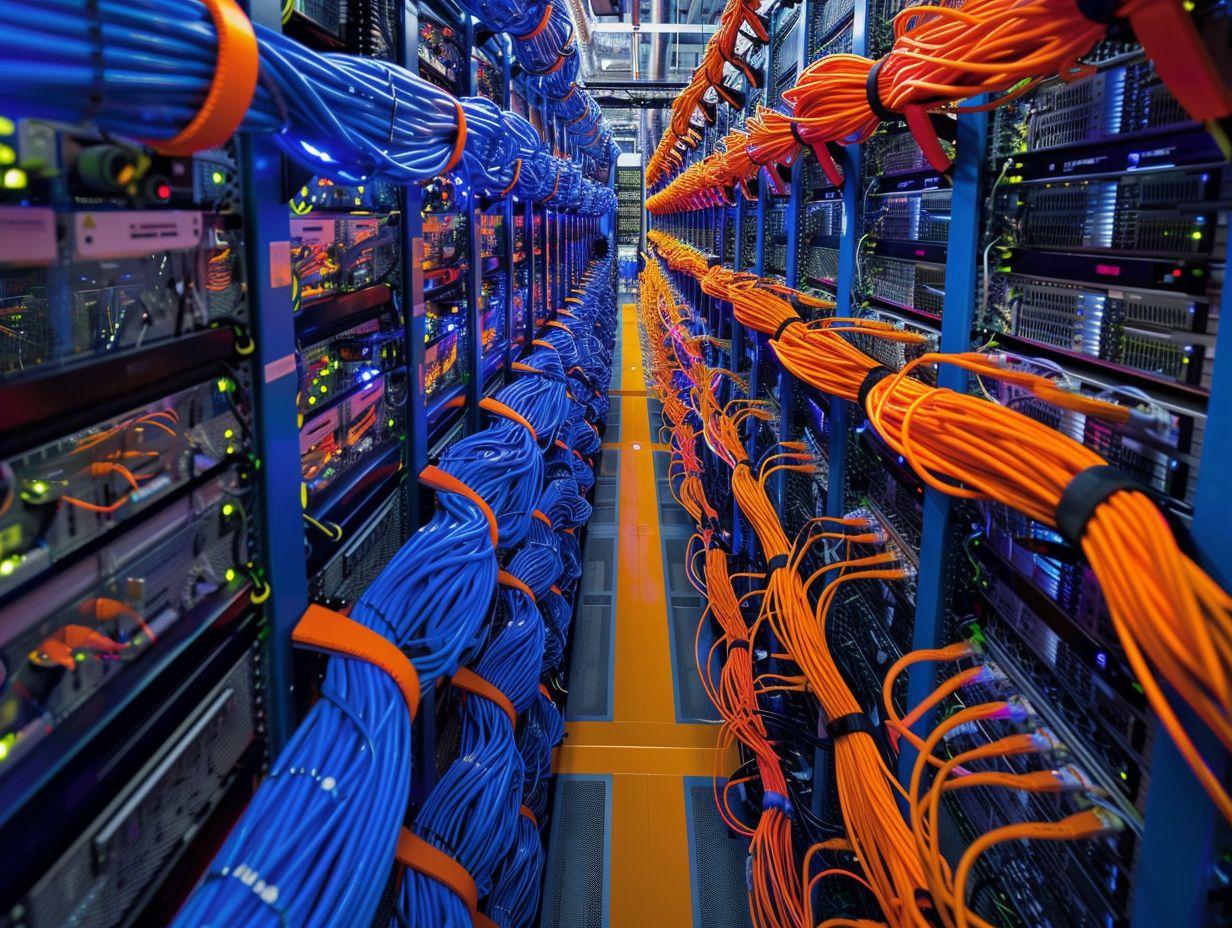Data center integration is a critical strategy for optimizing efficiency and streamlining processes within a data center environment. By integrating storage, compute, and network components, your organization can realize significant benefits in terms of performance, scalability, and cost savings.
While the process presents challenges, this article delves into the advantages of data center integration, common obstacles organizations encounter, best practices for successful integration, available tools and technologies, as well as future trends and predictions in the field.
Whether you are seeking to improve your data center infrastructure or maintain a competitive edge, this article offers valuable insights into the realm of data center integration.
Key Takeaways:

What is Data Center Integration?
Data Center Integration refers to the process of combining computing, storage, and network resources into a unified infrastructure to enhance operational efficiency and performance. By integrating these core components, you can streamline your company’s IT operations, leading to improved scalability, agility, and resource utilization.
When all components work seamlessly together, it allows for easier scaling up or down based on demand fluctuations, ensuring resources are efficiently allocated. Additionally, this integration fosters quicker deployment of new services and applications, enhancing your organization’s agility in meeting changing business requirements.
Data center integration eliminates silos, enabling cross-functional teams to collaborate more effectively and leverage synergies across different parts of the infrastructure.
Benefits of Integrating Storage, Compute, and Network
Incorporating storage, compute, and network components in a data center environment provides numerous benefits, such as increased scalability, improved performance, and simplified maintenance procedures.
Streamlining Processes and Improving Efficiency
Streamlining processes and enhancing efficiency are core objectives of data center integration, allowing for optimized resource allocation and reduced operational complexity.
By implementing integrated systems in your data centers, your organization can leverage automation tools to increase efficiency and accuracy in tasks such as data management and monitoring. The scalability of integrated systems enables your data centers to easily accommodate growth and fluctuations in demand, ensuring smooth and uninterrupted operations. Resource optimization through integrated systems minimizes wastage and redundancy, leading to cost savings and improved overall performance. These streamlined processes contribute to enhanced agility in adapting to changing market conditions and technological advancements in the data center environment.
Challenges of Data Center Integration

Despite the numerous benefits, integrating data center components poses various challenges for you, such as ensuring seamless interoperability, managing data security risks, and addressing compatibility issues.
Common Obstacles and How to Overcome Them
Common obstacles in data center integration for you may include dealing with legacy system constraints, navigating through data migration complexities, and establishing robust disaster recovery mechanisms. To conquer these challenges, you must engage in meticulous planning, thorough testing, and the implementation of efficient migration strategies.
In ensuring seamless integration between your legacy systems and new infrastructure, it is imperative that you adopt effective data replication practices. Utilizing real-time replication technologies can help minimize downtime during migration processes. Additionally, compliance with industry regulations such as GDPR or HIPAA must be maintained.
Regular audits and updates to your disaster recovery plan are crucial to ensuring data protection and integrity. By proactively addressing these aspects, you can mitigate risks and achieve successful data center integration.
Best Practices for Integrating Data Center Components
Incorporating best practices is essential for the successful integration of data center components, which involves meticulous planning, standardized architectures, and ongoing monitoring to ensure optimal performance.
Key Considerations for Successful Integration
When integrating data center components, you need to carefully consider factors such as scalability, security, compliance, and interoperability for smooth operations and optimal performance.
Scalability is essential because organizations must plan for future growth and adaptability when designing their data centers. Robust security measures, including data protection tools like encryption and access control, are crucial to protect sensitive information. Compliance with regulations ensures that legal obligations are fulfilled, reducing the risk of violations. Seamless connectivity among different components and systems improves efficiency and productivity. Addressing these key factors in data center integration establishes a solid foundation for a stable and successful operational environment.
Tools and Technologies for Data Center Integration

Various tools and technologies are at your disposal for data center integration, including DCIM solutions, network automation platforms, hyperconverged infrastructure such as Cisco HyperFlex, and bare metal servers offered by Packet.
Overview of Available Solutions
Various solutions are available to streamline data center integration, ranging from cloud-based services like AWS Outposts and Equinix offerings to on-premise solutions such as Cisco UCS and ACI for network management.
These solutions cater to businesses of all sizes, providing scalability to meet expanding data requirements. Cloud-based options offer flexibility by enabling users to access resources remotely, while on-premise solutions ensure a higher level of control over data security. Connectivity features are enhanced through virtualization techniques, enabling efficient data transfer and management. Hybrid cloud environments combine the advantages of both cloud and on-premise setups, offering a well-rounded approach that capitalizes on the strengths of each. These varied solutions assist organizations in optimizing their data center operations for enhanced performance and reliability.
Future of Data Center Integration
The future of data center integration is set for ongoing innovation, as emerging trends such as edge computing, hybrid cloud architectures, and advanced network automation are reshaping the landscape of IT infrastructure.
Trends and Predictions
Key trends and predictions in data center integration include the growing adoption of edge computing solutions, increased reliance on hybrid cloud architectures, and the rise of network automation technologies for enhanced efficiency and agility.
The evolution of data center integration is closely tied to the shifting landscape of technology and infrastructure. With the surge in edge computing applications, organizations are redefining their strategies to accommodate processing closer to the source of data generation. This not only minimizes latency but also optimizes resource allocation. Hybrid cloud deployments continue to gain traction, leveraging the flexibility and scalability of public cloud services like AWS Direct Connect to seamlessly work together with on-premises systems. Advancements in network automation, particularly through AI-driven solutions, are streamlining operations and enableing IT teams to focus on strategic initiatives. Looking ahead, the integration of AWS Snow Family offerings is set to revolutionize data management by facilitating secure and efficient data transfer between edge locations and the cloud.
Frequently Asked Questions

What is meant by integrating data center storage with compute and network?
Integrating data center storage with compute and network refers to the process of connecting and synchronizing the storage, computing, and networking components within a data center to work seamlessly together and efficiently manage data flow and storage needs.
Why is it important to integrate data center storage with compute and network?
Integrating data center storage with compute and network allows for more efficient data management and easier access to data for users. It also helps to optimize resource utilization and reduce costs by eliminating data redundancy and improving data transfer speeds.
What are the benefits of integrating data center storage with compute and network?
Some benefits of integrating data center storage with compute and network include improved data security, increased data availability, and better scalability and flexibility for future data storage needs.
What are the components involved in integrating data center storage with compute and network?
The main components involved in integrating data center storage with compute and network include storage devices such as hard drives and solid-state drives, computing resources like servers and virtualization software, and network infrastructure such as switches and routers.
How does virtualization play a role in integrating data center storage with compute and network?
Virtualization is a key component in integrating data center storage with compute and network as it allows for the creation of virtual servers and storage devices, making it easier to manage and allocate resources for storage and computing needs.
What are some challenges to consider when integrating data center storage with compute and network?
Some challenges to consider when integrating data center storage with compute and network include data compatibility and migration, ensuring data security and privacy, and maintaining consistent performance across the integrated components.
